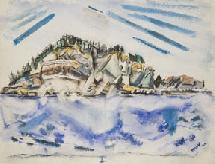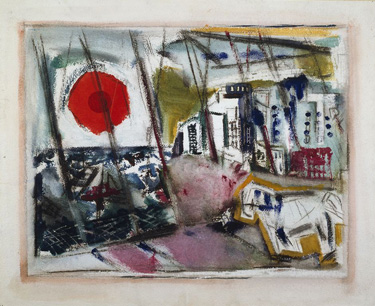A couple of weeks ago I went to the Portland Museum of Art to see its exhibition of paintings and works on paper by John Marin, one of my favorite American modernists. A similar show is currently on view at Atlanta’s High Museum. In my “Sightings” column for today’s Wall Street Journal I explore the question of why Marin, who was for much of the twentieth century one of America’s leading artists, is no longer widely known. Here’s an excerpt.
* * *
 Sooner or later, everyone who writes about John Marin gets around to mentioning the 1948 Look magazine poll of 68 critics, curators and museum directors who, when asked to name America’s greatest living painters, put him at the top of the list. Five years later, the headline of Marin’s New York Times obituary described him as “Artist Considered by Many as ‘America’s No. 1 Master’.” No less a highbrow than the art critic Clement Greenberg concurred, predicting that Marin and Jackson Pollock would “compete for recognition as the greatest American painter of the 20th century.”
Sooner or later, everyone who writes about John Marin gets around to mentioning the 1948 Look magazine poll of 68 critics, curators and museum directors who, when asked to name America’s greatest living painters, put him at the top of the list. Five years later, the headline of Marin’s New York Times obituary described him as “Artist Considered by Many as ‘America’s No. 1 Master’.” No less a highbrow than the art critic Clement Greenberg concurred, predicting that Marin and Jackson Pollock would “compete for recognition as the greatest American painter of the 20th century.”
So why does Marin so often get the “John Who?” treatment? For it’s better than even money that unless you happen to be a connoisseur of American modernism or an art-history major, his name is unknown to you. It’s been 21 years since a major American museum last put together a full-scale retrospective of his work. New York’s Museum of Modern Art owns 25 Marins–but not a single one of them is currently on view.
To be sure, Marin has his share of passionate admirers, and important Marin exhibitions have just been simultaneously mounted by two medium-sized American museums, Maine’s Portland Museum of Art (up through Oct. 10) and Atlanta’s High Museum (up through Sept. 11). The catalogues of both shows are highly impressive pieces of work, and between them they make a powerful case for taking a second look at Marin–but their authors are quick to admit that such a look is now necessary, since Marin has in recent years fallen into something not far removed from obscurity. Indeed, the foreword to Portland’s “John Marin: Modernism at Midcentury” catalogue goes so far as to describe him as “the missing man among the pantheon of great American modernists.”
 As I strolled through the Portland show the other day, I found myself wondering yet again how so explosively vital a painter could have dropped off the scope. A bold colorist who viewed the American landscape through the kaleidoscopic prism of cubism, Marin conveyed with identical precision and sympathy the nervous angularity of lower Manhattan (“City Movement,” 1940) and the ceaseless turmoil of the waves that break on the coast of Maine (“Outer Sand Island, Maine,” 1936). Like all prolific artists, he was uneven in inspiration, but having seen dozens of his watercolors–he painted some 2,500 of them–I’m struck by how many are not just effective but indelibly memorable….
As I strolled through the Portland show the other day, I found myself wondering yet again how so explosively vital a painter could have dropped off the scope. A bold colorist who viewed the American landscape through the kaleidoscopic prism of cubism, Marin conveyed with identical precision and sympathy the nervous angularity of lower Manhattan (“City Movement,” 1940) and the ceaseless turmoil of the waves that break on the coast of Maine (“Outer Sand Island, Maine,” 1936). Like all prolific artists, he was uneven in inspiration, but having seen dozens of his watercolors–he painted some 2,500 of them–I’m struck by how many are not just effective but indelibly memorable….
* * *
Read the whole thing here.
Terry Teachout on the arts in New York City
An ArtsJournal Blog
